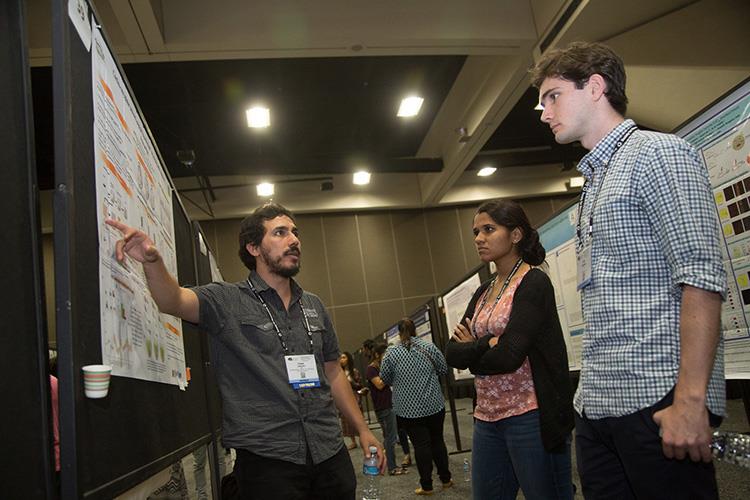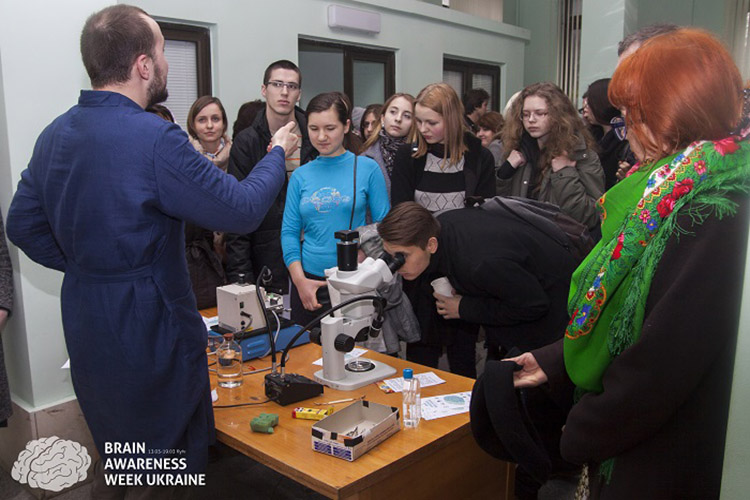
Inspiring the Future Generation of Neuroscientists
Neuron, synapse, action potential — not words you typically hear in conversations with teenagers and young adults. But when walking the poster floor at the Brain Awareness Campaign Event at the Society for Neuroscience’s 2016 annual meeting, the air was full of such words spoken by high schoolers and college students.
This is music to the ears of Frances Jensen, professor and chair of neurology at the University of Pennsylvania and chair of SfN’s Public Education and Communication Committee (PECC), which seeks to make neuroscience more accessible to the public, and specifically young students.
“The committee works very hard thinking about how we can get kids at all ages — primary school, high school and college — interested in the brain in general, but also potentially interested in a career in science,” she said.
SfN helps inspire young students’ interest in neuroscience through activities such as Brain Awareness Week (BAW), the Brain Awareness Video Contest (BAVC), and the Brain Bee, all of which encourage active engagement in learning about the brain. “You learn better when you participate, when you actually use knowledge,” Jensen said. “It really sinks in more and we find that there's a tremendous amount of enthusiasm in learning that goes along with that.”
SfN sponsored the attendance of some of the young students at its annual meeting, including the 2016 winners of the U.S. Brain Bee, the BAVC, and the U.S. Science Olympiad’s Anatomy & Physiology event.
“I'm ecstatic. I just love being here,” said Akshay Balaji, a student from Thomas Jefferson High School for Science and Technology in Alexandria, Va. “I didn't ever expect that I'd get this opportunity as a high schooler. Just seeing all the research, all the presentations, being in an environment where everyone has the same mindset, is very excited about neuroscience.”
Balaji participated in the D.C. Regional Brain Bee, hosted by SfN, and that’s how he learned about SfN’s Brain Awareness Video Contest, in which participants work with an SfN member to produce an educational video that explains a neuroscience concept in a way that engages the public. Balaji won the competition with his video “Hearing Red, Tasting Blue: When the Senses Mix.”
“My impression of the SfN meeting is it's amazing,” said Ronald Wang, the National Science Olympiad Anatomy and Physiology champion from West Windsor-Plainsboro High School North in New Jersey. “It's a heaven for neuroscience-interested people.”
“Everyone here is really passionate about neuroscience, and you can really see that in the talks,” added Wang’s Science Olympiad teammate, Jason Yang.
In addition to engaging these young students directly through brain awareness programs, Jensen also emphasized the necessity of scientists working with K-12 educators to bring neuroscience into the classroom. She pointed to the educator resources and classroom activities provided on SfN’s public educational website, BrainFacts.org, as a great tool for teachers.
“You have to lay the ground work early to cultivate interest,” Jensen said.
John Meitzen, an assistant professor at North Carolina State University, agreed that working with educators could exponentially increase the reach of neuroscientists’ outreach efforts to their local communities. Meitzen won SfN’s 2016 Next Generation Award for his outstanding contributions to public communication, outreach, and education about neuroscience, and specifically for his role as one of the pioneers of the annual Brain Awareness Night at the North Carolina Museum of Natural Sciences.
“If I visit with one kid, and maybe I've planted a seed that will sprout at some point, but I've only reached one kid,” he said. “If I can help a teacher, if I can outreach to an educator, that individual trains dozens, and dozens, hundreds, and hundreds, maybe thousands of students over the course of a year or throughout their career."



















